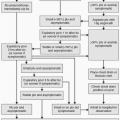Transjugular Intrahepatic Portosystemic Shunts
Ziv J. Haskal
A transjugular intrahepatic portosystemic shunt (TIPS) is a percutaneous method of reducing portal vein pressure for treatment of complications of portal hypertension. A decompressive channel is created between a hepatic vein and an intrahepatic branch of the portal vein. Creating a TIPS involves several steps:
1. Catheterization of the hepatic veins and hepatic venography
2. Passage of a long, curved transjugular needle from the chosen hepatic vein through the liver parenchyma into an intrahepatic branch of the portal vein
3. Direct measurement of the systemic and portal vein pressures through the transjugular access
4. Balloon dilatation of the tract between the hepatic and portal veins
5. Deployment of an expanded polytetrafluorethylene-lined stent graft or metallic stent within the tract to maintain it against the recoil of the surrounding liver parenchyma and tissue ingrowth
6. Angiographic and hemodynamic assessment of resultant pressure changes
7. Serial dilatation of the stent until satisfactory pressure levels have been reached
8. Variceal embolization, when indicated
1. Efficacy determined by controlled trials:
a. Secondary prevention of variceal bleeding
b. Refractory cirrhotic ascites
2. Efficacy assessed in uncontrolled series:
a. Refractory acutely bleeding varices
b. Portal hypertensive gastropathy
c. Bleeding gastric varices
d. Refractory hepatic hydrothorax
e. Hepatorenal syndrome (type 1 or 2)
f. Budd-Chiari syndrome
3. Unclear, variable efficacy described in small series or case reports
a. Veno-occlusive disease (VOD)
b. Hepatopulmonary syndrome
c. Prophylactic preoperative decompression
d. Restoration of portal vein patency prior to transplantation or during catheter directed therapy of splenomesenteric thromboses
Contraindications
Absolute
1. Severe or rapidly progressive liver failure
2. Severe or uncontrolled encephalopathy
3. Heart failure
4. Severe pulmonary hypertension
These contraindications hold for most surgical portosystemic diversion procedures. Patients with very advanced stages of liver disease will not tolerate deprivation of nutrient portal flow that occurs after total or partially decompressive shunts. In these cases, shunts may accelerate liver failure and should be considered only as last measures, ideally as bridges to imminent transplantation.
Relative
1. Contraindications to angiographic procedures
a. Recent myocardial infarction, serious arrhythmia, or substantial electrolyte imbalance
b. Past serious documented contrast reaction—prophylaxis is required, or TIPS creation using carbon dioxide
c. Uncorrectable coagulopathies
d. Inability to lie flat on angiographic table due to congestive heart failure or compromised respiratory status—intubation may be required
e. Pregnancy because of risk of exposure of fetus to ionizing radiation
2. Conditions that may increase the technical difficulty of creating a TIPS:
a. Biliary obstruction
b. Hepatic or pancreatic malignancy
c. Polycystic liver disease
d. Inferior vena caval or hepatic vein thrombosis
e. Portal system thromboses (portal, splenic, or mesenteric)
f. In cases of caval, hepatic vein, or portal system thromboses, modified procedures using transcaval, transhepatic, or transplenic approaches have been described. Targeting can be further aided by use of intravascular ultrasound (IVUS) for creation of TIPS in routine approaches, direct intrahepatic portosystemic shunt (DIPS), or complex anatomy.
Preprocedure Preparation
1. Obtain informed consent. Table 40.1 lists procedural complications that can be discussed with the patient (7).
2. Preprocedure sonography, computed tomography (CT), or magnetic resonance (MR) imaging to assess portal vein patency and hepatic parenchyma because the incidence of hepatocellular carcinoma is increased in patients with cirrhosis.
3. Provide standard hemodynamic monitoring, including electrocardiogram (ECG), oxygen saturation, blood pressure, and possibly capnography, as appropriate for administration of sedation per hospital protocols.
4. In acutely bleeding patients, ensure that satisfactory resuscitation efforts are being undertaken prior to starting. These may include blood or plasma transfusions, pressor support, and placement of balloon tamponade catheters. Generally, platelet counts are corrected to >50,000/µL and international normalized ratio to ≤1.5.
5. Intravenous antibiotic prophylaxis should be provided. Many medications may provide satisfactory coverage, including ceftriaxone, ampicillin/sulbactam, or, in penicillin-allergic patients, levofloxacin, ciprofloxacin, clindamycin, or vancomycin.
6. TIPS can be created under conscious sedation with intravenous fentanyl and midazolam. When anesthesia support is available, many centers use general anesthesia, especially for pediatric patients, or monitored anesthesia care (MAC) with propofol administration.
7. Assemble required components:
a. TIPS set. Several kits exist, including the Haskal, Rösch-Uchida, and Ring sets (Cook Medical, Bloomington, IN). The factor most governing kit choice is operator preference. The Haskal and Rösch-Uchida sets are suitable for VIATORR delivery (W. L. Gore & Associates, Flagstaff, AZ), by virtue of the inclusion of a 10 Fr. vascular sheath. The Ring set contains a 9 Fr. vascular sheath, suitable for delivering bare metal stents, not U.S. Food and Drug Administration (FDA)-approved TIPS endografts.
b. Metallic stents. Nearly every available metal stent has been used to support the parenchymal tract of a TIPS, including balloon expandable, selfexpanding braided and laser-cut nitinol stents, and polytetrafluoroethylene (PTFE) stent grafts. However, only two devices are FDA-approved specifically for use in TIPS creation: the WALLSTENT (bare stent) and the VIATORR (expanded polytetrafluoroethylene [ePTFE]-lined stent graft) (8,9,10,11,12,13,14).
Table 40.1 Procedural Complications of Transjugular Intrahepatic Portosystemic Shunts | ||||||||||||||||
|---|---|---|---|---|---|---|---|---|---|---|---|---|---|---|---|---|
| ||||||||||||||||







